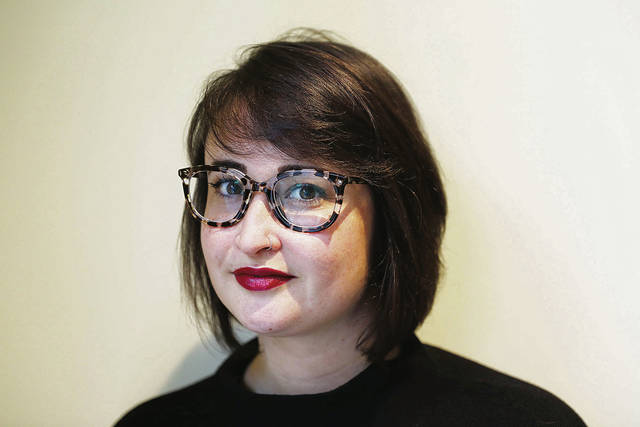‘I lived a life and it was wonderful’: Portrait series makes seniors the stars

COURTESY SEATTLE TIMES
Summit at First Hill resident Essie Fleisch holds a copy of her photo, given to her for particating in the “Faces of the Summit” project.

COURTESY SEATTLE TIMES
The portraits of over 20 residents — all between the ages of 85 to 102 — are featured in the “Faces of the Summit” project that are accompanied by their reflections on aging, and other experiences.

KEN LAMBERT/SEATTLE TIMES/TNS
“I don’t get to interact much with older people. And I learned that I want to do that more. Because I learned so much. So many of them don’t take things too seriously.”
Jessica Keener
Project’s photographer



SEATTLE >>
We don’t know how good we have it with our cellphones and bike shares. Our labor laws and dating apps. Our good hips and sharp eyes.
And yet, the residents of The Summit at First Hill retirement home wouldn’t trade their lives for any of those things. That would mean losing their own stories and memories, things they have not only lived, but lived to tell.
That’s the take-away from “The Faces of The Summit,” a photo exhibit that captures the faces and words of more than 20 residents ranging in age from 85 to 102. The exhibit is hanging in a horseshoe of hallways on the home’s first floor and is open to the public. There’s no plan to take it down.
When the exhibit opened recently, the place had the feel of a school event. Excited family and friends filled the lobby while residents jockeyed their walkers around corners, lingered near their own photographs or sat on couches, basking in the new attention.
The exhibit was planned by Marilyn Israel and Leslie Block of The Summit’s Life Enrichment team. They couldn’t believe the response. Just that morning two residents were on the TV news, and here I was with a photographer.
Don't miss out on what's happening!
Stay in touch with breaking news, as it happens, conveniently in your email inbox. It's FREE!
“We didn’t think of it being newsworthy,” Block said.
“Our intent was to create an interesting activity for the residents,” Israel said. “We were trying to honor the elders.”
Said Block: “We look at people, but do we really see them?”
Residents volunteered to be part of the exhibit, and had their hair and makeup done by volunteer Valerie Spencer — a Mary Kay representative.
“I think when they get to be this age sometimes they give up hope,” Spencer said. “And they think, ‘Why bother?’ Here, they felt like Queen for a Day. Younger.”
“And empowered,” Israel added. “All of a sudden, they felt very special.”
“It shows in the pictures,” said Block. “They got swag.”
Photographer Jessica Keener, who is just 30, said she was changed by her experience with the residents.
“I don’t get to interact much with older people,” she said. “And I learned that I want to do that more. Because I learned so much. So many of them don’t take things too seriously.”
How it all started
Block did most of the interviews. She started by asking residents for life advice. If that drew “a blank stare,” she said she would ask them to describe a favorite experience or a favorite memory.
“Some people would say, ‘My life was boring,’ and I’d ask, ‘Where were you born?’ and then once they started talking … “
That’s how they learned that resident Michaela Lobel, 94, had been hit by an SUV while crossing the street in her native New York City, where she lived until just a couple of years ago. (“I came here, naturally, because of my daughter,” Lobel told me. “Ninety-seven percent of the people are here because of their daughters.”)
Lobel told Block about the doctor who took her right hand as she lay in the street, asking if she knew her own name, and the messenger who took her other hand and told her, “Yo, Momma. You’re gonna be all right.”
Frieda Feinberg was born in Dresden, Germany. When she and her mother tried to board a ship bound for the United States, they were turned down. Two days later, they boarded another boat and learned that the first one had sunk.
“I know, I know,” Feinberg said as we stood in front of her portrait. “When I think about it more, why were my mother and I selected not to go on the original ship?”
Her husband, Schick, recalled being stationed in Tokyo during World War II and walking to synagogue one Friday night when they ran into Gen. Douglas MacArthur. “Glad to see we have some pious young soldiers,” MacArthur told them.
The Feinbergs have two children, nine grandsons, 53 great-grandchildren and two great-great-grandchildren, and lost a daughter six years ago.
“You’ve got to keep living, you know?” Frieda said. “People realize that if they weren’t here, well, they may not be alive.”
Jack Moshcatel, 89, had just been dropped off after having breakfast with his children in Columbia City, where he lived before moving into The Summit two years ago. (“My kids suggested it,” he said.)
Moshcatel wasn’t interested in taking a look at his portrait with me. The Seahawks game had already started, and, after all, “the guy in the portrait is much better looking than I am.”
Seattle gave him a good life, he said. Work, kids, community. He still goes down to the old neighborhood to get his hair cut — but in an Uber.
“But I miss being able to do what I’d like to do,” he said. “Don’t grow old. That’s all I can tell you.”
Essie Fleisch was married twice. She met her first husband when he approached her at an event and asked her to dance. Her second husband took her on the Staten Island Ferry on their first date. “You wouldn’t believe how romantic the Staten Island Ferry can be.”
Irma Hillman talked about how much she loved teaching. Sylvia Slomin Hayden wrote a poem called “My Day.” Adele Sharaga helped raise the money to build a hospital and calls herself “the luckiest mother at The Summit” because she lives just two blocks from her son, Ken.
The love of baking
Katherine Scharhon wrote about her love of baking, and how she has made “thousands” of borecas pastries, keeping a Sephardic tradition.
Naomi Henryson, 102, offered up the secret to a long life: “There is no secret.”
Alan Stone used to wake up every morning, look at his wife, Bonnie, and say “I’m sorry.” He figured it gave him a pass for the rest of the day.
Lobel was surprised at what she learned about other residents, and what she shared with Block and the photographer.
“I haven’t been telling people all this stuff,” she said. “Maybe I just wanted to say I lived a life and it was wonderful. And these are my memories.”
As she spoke, her bracelet kept clicking against the table. She held it up. It was clear plastic, with insects embedded within, as if caught in amber.
“This is iconic,” she said, adding that she bought it from a street vendor at Columbus Circle who lived in the Bronx. He was shot 41 times by New York City police officers who mistook him for a rape suspect and thought he was reaching for a gun.
Wait a second, I said. She was referring to Amadou Diallo, whose death made international news.
“That was Amadou,” she said. The killing of Diallo was referenced in songs by everyone from Bruce Springsteen to Wyclef Jean to jazz trumpeter Roy Campbell Jr. to Lauryn Hill.
“That was him,” she said. “I have met incredible people.”
She was lost in thought for a moment, then turned back to me.
“So here I am at The Summit.”





